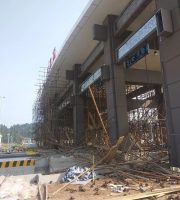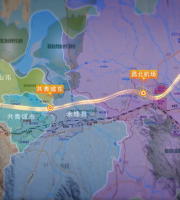The “Three Treasures” are the three essential safety measures for construction workers, namely safety helmets, safety belts, and safety nets; The “Four Ports” protection refers to the safety protection facilities for reserved openings, elevator shaft entrances, passage entrances, and staircase entrances in construction projects;.
1. All personnel entering the construction site must wear safety protective equipment correctly.
Hanging a dense mesh safety net on the outside of the construction project for closure;.
2. Protective railings should be installed at the elevator shaft and staircase entrances, protective sheds should be erected at the passage entrances, and protective railings and covers should be installed for reserved openings according to specific situations.
The “Five Edge” protection refers to the safety protection facilities for the floor edge, roof edge, balcony edge, lifting port edge, and foundation pit edge of the construction project in progress;.
1. The protective railing for high-altitude operations near the edge should be closed with a safety net from top to bottom;.
2. Edge protection must be equipped with double layered fences of at least 1 meter or safety nets;.
3. A protective fence with a height of not less than 1.2 meters shall be set up at the edge of excavation of foundation pits, ditches, and trenches.
1. Scaffolding operators must undergo professional training and obtain a job certificate;.
2. It is strictly prohibited to mix wooden or bamboo scaffolding with iron scaffolding. When the overall height exceeds 3 meters, the use of single row scaffolding is prohibited;.
3. The foundation of the scaffold must be flat and solid, with drainage measures in place. The scaffold must be supported on a base (bracket) or a full-length scaffold board;.
4. The scaffold construction operation surface must be fully covered with scaffold boards, and the distance from the wall surface must not be greater than 20 centimeters. There must be no gaps, probe boards, or flying boards; A protective railing and a 10 centimeter toe board should be installed on the outer side of the operating surface;.
Ringlock Scaffolding Ledger End
5. The frame must be enclosed along the inner side of the outer frame with a dense mesh safety net. The safety nets must be firmly connected, tightly sealed, and fixed to the frame.
Floor standing scaffolding is a scaffolding erected along the ground on the outer side of a building. The most common type during construction is steel pipe scaffolding, and the following precautions should be taken when erecting it:.
3. The upright pole of the scaffold should be placed vertically on a metal base or wooden pad;.
4. Hand and foot frames must be equipped with vertical or horizontal sweeping rods. 18 Analysis of safety hazards of probe boards due to insufficient horizontal rods in scaffolding. 18 Analysis of safety hazards of probe boards due to insufficient horizontal rods in scaffolding.
According to the laying of the scaffold board, it is necessary to add horizontal bars. The homework layer scaffold board should be set on three horizontal bars. When the length of the scaffold board is less than 2m, two horizontal bars can be used to support it, but the two ends of the scaffold board should be reliably fixed to the horizontal bars to prevent tipping over. When the scaffold board is overlapped and laid, the joint should be supported on the horizontal bar, and the overlap length should not be less than 200mm. The length of its extension from the horizontal bar should not be less than 100mm; The bamboo scaffold board should be laid perpendicular to the longitudinal horizontal bar direction according to its main bamboo reinforcement, and the four corners should be fixed on the longitudinal horizontal bar with galvanized steel wire with a diameter of not less than 1.2mm; The probe length of the scaffold board at the end of the homework layer should be taken as 150mm, and both ends of the board should be fixed to the supporting rod..
Failure to install horizontal bars according to the requirements of scaffold board laying can result in loose, unstable, and unstable scaffold board laying, forming probe boards and flying boards. When the scaffold board is stepped on by workers, it is prone to overturning or rolling, causing workers or objects to fall from heights and posing a danger to material transportation and high-altitude operations..


